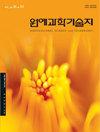温室气温和根区温度对番茄早期生长的影响
IF 0.8
4区 农林科学
Q3 HORTICULTURE
Korean Journal of Horticultural Science & Technology
Pub Date : 2023-08-31
DOI:10.7235/hort.20230036
引用次数: 0
摘要
本研究通过对番茄根区进行温度控制,建立了一种有效的番茄早期栽培方法。温室空气温度在白天(12小时)保持在20、25、30和35℃,在夜间(12小时)保持在18℃。在不同的空气温度下,根区温度分别设置为15、20、25、30℃。当空气温度为30℃时,根区温度调节为25℃和30℃,当空气温度为35℃时,根区温度调节为20℃和25℃,幼苗生长最佳。在所有空气温度条件下,根区温度为20℃时,根长总体生长有利。在空气温度为35℃和根区温度为25℃的组合处理下,叶面积和叶数的生长最好。在根区温度为15℃时,由于根系生长受到抑制,T/R比达到最大值。在全空气温度处理下,根区温度为20℃时,番茄幼苗密实度较高。在根区温度为20℃时,各温度处理的作物生长速率(CGR)和相对生长速率(RGR)均较好。综合试验结果可知,在25℃、30℃和35℃的空气温度下,根区温度设置为20℃或25℃对番茄早期生长是有效的。本研究的结果可以帮助在高温和低温条件下调节作物的早期生长。本文章由计算机程序翻译,如有差异,请以英文原文为准。
Effects of the Air Temperature and Root Zone Temperature in Greenhouses on the Early Growth of Tomatoes
In this study, experiments were conducted to develop an efficient method of the early cultivation of tomatoes by implementing temperature control in the root zone. The greenhouse air temperature was maintained at 20, 25, 30, and 35°C during the daytime (12 hours) and at 18°C during the nighttime (12 hours). The experiment was conducted by setting the root zone temperature to 15, 20, 25, and 30°C for each air temperature. The growth of seedlings was found to be optimal when the root zone temperature was adjusted to 25 and 30°C for an air temperature of 30°C and the root zone temperature was adjusted to 20 and 25°C for an air temperature of 35°C. Regarding the root length, overall growth was favorable when the root zone temperature was adjusted to 20°C across all air temperature conditions. The leaf area and number of leaves showed the best growth when treated with a combination of an air temperature of 35°C and a root zone temperature of 25°C. The T/R ratio reached its high point at a root zone temperature 15°C due to the inhibited root growth. The compactness of tomato seedlings was high in the treatment with a root zone temperature of 20 in all air temperature treatment. The CGR (crop growth rate) and RGR (relative growth rate) were favorable at the root zone temperature of 20°C at all air temperature treatments. Based on the overall experimental results, it can be concluded that setting the root zone temperature to 20 or 25°C is effective for the early growth of tomatoes at air temperatures of 25, 30, and 35°C. The results of this study can help when regulating the early growth of crops in high and low air temperature conditions.
求助全文
通过发布文献求助,成功后即可免费获取论文全文。
去求助
来源期刊
CiteScore
2.00
自引率
0.00%
发文量
0
审稿时长
1 months
期刊介绍:
Horticultural Science and Technology (abbr. Hortic. Sci. Technol., herein ‘HST’; ISSN, 1226-8763), one of the two official journals of the Korean Society for Horticultural Science (KSHS), was launched in 1998 to provides scientific and professional publication on technology and sciences of horticultural area. As an international journal, HST is published in English and Korean, bimonthly on the last day of even number months, and indexed in ‘SCIE’, ‘SCOPUS’ and ‘CABI’. The HST is devoted for the publication of technical and academic papers and review articles on such arears as cultivation physiology, protected horticulture, postharvest technology, genetics and breeding, tissue culture and biotechnology, and other related to vegetables, fruit, ornamental, and herbal plants.

 求助内容:
求助内容: 应助结果提醒方式:
应助结果提醒方式:


